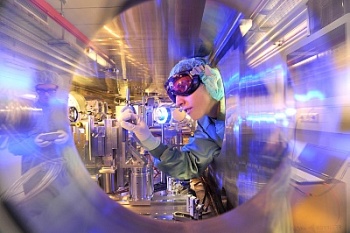Jun 6 2013
From June 3 through 5, 2013, some 150 experts from around the World are meeting up in Hamburg at accelerator center DESY. Their shared focus will be on setting up a new experimental station with the goal of coupling X-ray light from the free electron laser XFEL with intense light flashes from a compact and powerful laser system.
 Ph.D. student Josefine Metzkes and her colleagues are adjusting the light of high-power laser DRACO to the ELBE accelerator’s electron beam in this prototype of a new experimental chamber at the Helmholtz-Zentrum Dresden-Rossendorf. The result: brilliant X-ray light. Photo: HZDR/Frank Bierstedt
Ph.D. student Josefine Metzkes and her colleagues are adjusting the light of high-power laser DRACO to the ELBE accelerator’s electron beam in this prototype of a new experimental chamber at the Helmholtz-Zentrum Dresden-Rossendorf. The result: brilliant X-ray light. Photo: HZDR/Frank Bierstedt
The international user consortium is headed by the Helmholtz-Zentrum Dresden-Rossendorf (HZDR); the project itself is a collaborative between DESY and the HZDR.
Brilliant X-ray light is in demand – across a range of scientific disciplines. It offers more in-depth insights into the structure of materials, cells, molecules, and atoms and allows scientists to probe extremely short biological, chemical, and physical processes. This explains why new X-ray light sources like the European X-ray laser XFEL in Hamburg are popping up all over the World. The ultimate goal is to combine XFEL’s X-ray light with the light of a high-power laser. Participants of the "Kick Off Meeting for the Helmholtz International Beamline for Extreme Fields (HIBEF) at the European XFEL” are planning to establish the user consortium for the HIBEF station as well as discuss the scientific program from June 3 through 5, 2013.
“This allows for a kind of a science and experiments, neither of which has ever been realized until now,” says HZDR’s Professor Thomas Cowan, the man in charge of the international user consortium that is setting up the HIBEF station. As such, the study of certain structural biological and geophysical processes only becomes possible if they are excited first by intense laser light and are then examined under bright X-ray light. But the new experimental setup will even allow for studies of the behavior of strong field vacuums and of matter under extreme conditions.
According to Cowan, “experiments at the XFEL, including those at the HIBEF, will be in high demand and very costly. Which is why we started preparing them experimentally at the HZDR as far back as two years ago.” At PHOENIX (PHOton Electron collider for Narrow bandwidth Intense X-rays), Dresden’s X-ray source, Cowan and his team successfully coupled an accelerator-powered electron beam with the intense light from a high-power laser. “Our DRACO laser covers an area of a mere 100 square meters, making it rather small compared to the XFEL. However, its compact size is actually a major advantage as it’s allowing us to install a similar laser at the XFEL with a reasonable amount of effort.”
The new HIBEF station is scheduled to commence operations at the European X-ray laser XFEL in 2018. Besides the two partners, DESY and the HZDR, others contributing to this sophisticated scientific project include the GSI Helmholtz Center for Heavy Ion Research, the Helmholtz Institute Jena, and institutes of the Max Planck Society.